The ‘Roman Gladiators’ were an early clue to Split’s historical heritage.
Clad in scarlet tunics, and grinning broadly as they swung their swords, they challenged tourists to a duel. A few accepted the challenge in exchange for a few Croatian Kuna, mock grimacing for the inevitable photographic evidence of their fight.
Built by the eponymous Roman Emperor, the UNESCO World Heritage Site of Diocletian’s Palace is one of the more unusual European palaces, having been transformed over the millennia into the tangle of churches, chapels and houses that now form Split’s medieval hub.
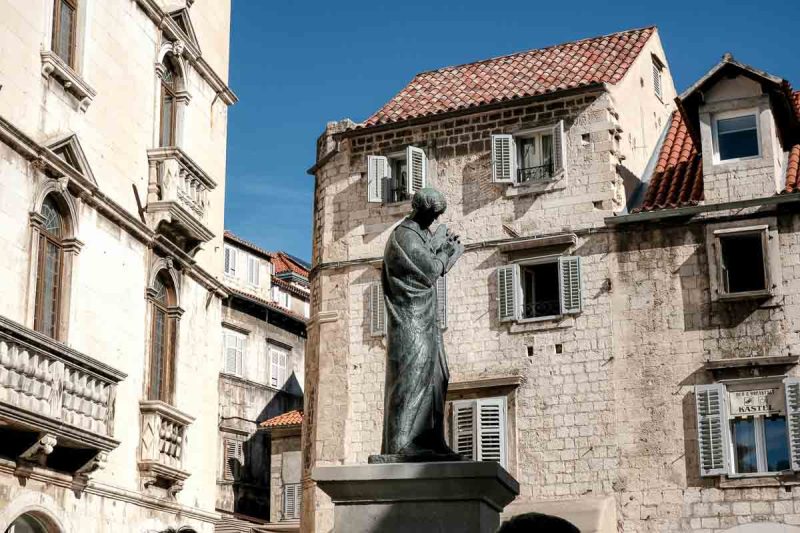
Some articles on this website contain affiliate links. This means that I may earn a small commission if you make a purchase through these links. As an Amazon Associate, I earn from qualifying purchases. Read the full disclosure here.
Diocletian’s Palace, Croatia: Timeline & Short History
Although he was the last Roman Emperor to declare himself divine, Diocletian had humbler origins.
Born in 245 AD to slaves in Dalmatia, he rose quickly through the ranks, becoming emperor at the tender age of 39. Upon his early retirement – unheard of for Roman emperors – a palace in Split was built for him to live out the rest of his days in splendour.
Diocletian’s Palace was completed in 305 AD. This fortified complex housed palatial apartments, a military garrison, temples and a mausoleum. After Diocletian’s death at the age of 66, the palace was occupied by a succession of despots before being abandoned in the sixth century.
In 614 AD, the population of the nearby town of Salona sought refuge from the invading Avars and Slavs behind its 20-foot thick walls. They then set about repurposing the palace’s former apartments into what must have been an enormous splendid squat.
The resulting city was absorbed into the Hungarian-Croatian kingdom in the eleventh century.
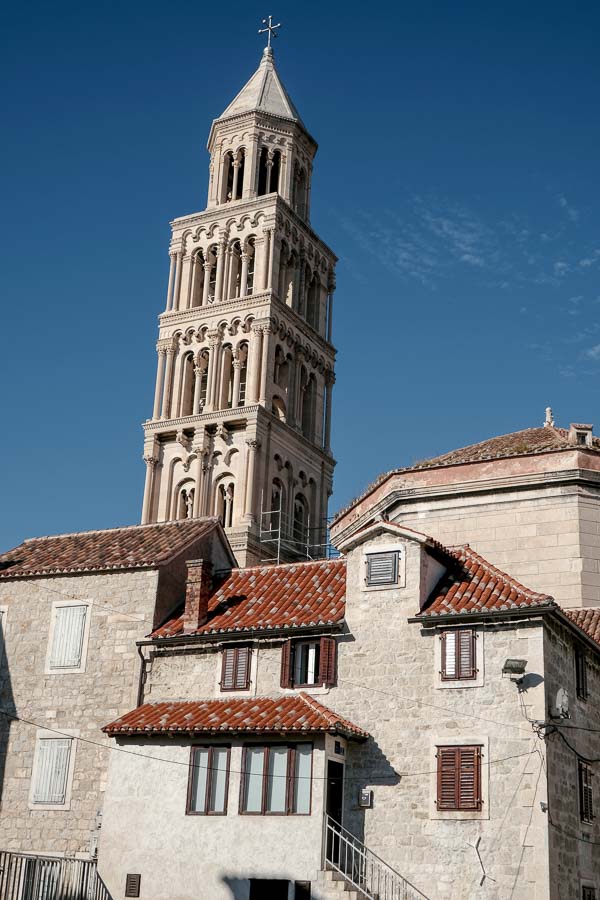
Exploring Diocletian’s Palace in Split Old Town
Diocletian’s Palace is living history. Far from being an archaeological site to be explored from the distance of a roped-off walkway, it serves as Split’s Old Town.
Preserved and restored buildings and structures blend seamlessly with contemporary life, culture and commerce. People continue to live and work where Diocletian lived out his twilight years.
This is what makes exploring Diocletian’s Palace special.
Although the columns and stones from the palace were recycled to build this area’s medieval tenements, the imperial apartments are long gone. However, key Roman buildings, clustered around the Peristyle (the central square), have been transformed into more modern iterations. The mausoleum is now Split’s cathedral; the Temple of Jupiter is the baptistry.
The Peristyle
The Peristyle, the epicentre of Diocletian’s Palace, is flanked by magnificent limestone arches and Corinthian columns.
A black granite sphinx takes pride of place, the last survivor of a group of twelve that Diocletian liberated from Egypt in 297 AD. This beautiful old girl is thought to be over 3,000 years old and probably kept watch over the emperor’s mausoleum.
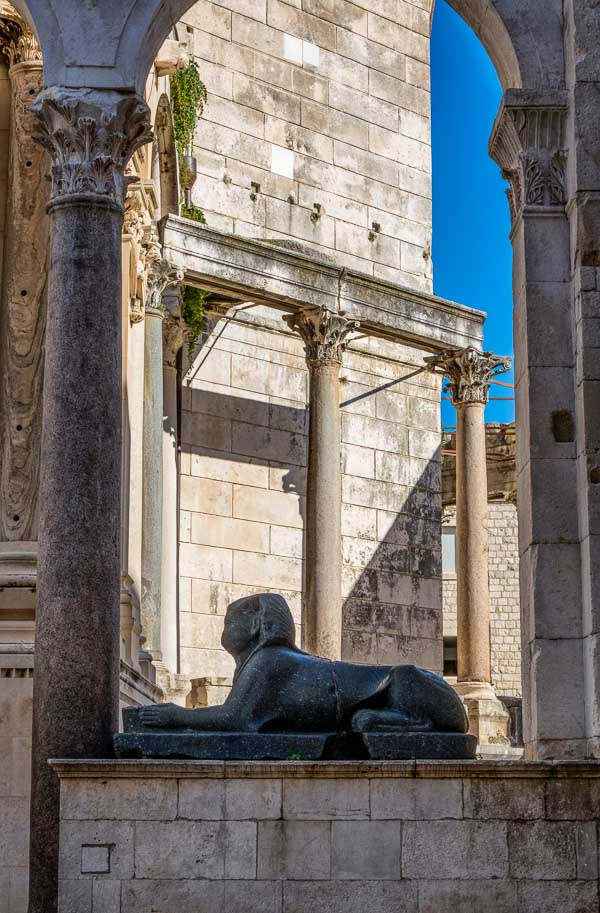
Cathedral of St Domnius (Diocletian’s Mausoleum)
Formerly known as Diocletian’s Mausoleum, the small Cathedral of St Domnius is one of the most unusual that I have visited.
Octagonal in shape, the world’s oldest Catholic church is surrounded by Corinthian columns and housed Diocletian’s mortal remains for at least 170 years until they disappeared. It’s thought that Christians ejected him in retribution for persecution at his hands.
I loved the cathedral’s high altar which is Baroque splendour and features a pair of gilded angels holding hands.
Crane your neck to examine the cathedral’s plain dome, which is the largest unsupported dome from Roman times that is still intact. Its base is embellished with a frieze depicting hunting scenes and racing chariots.
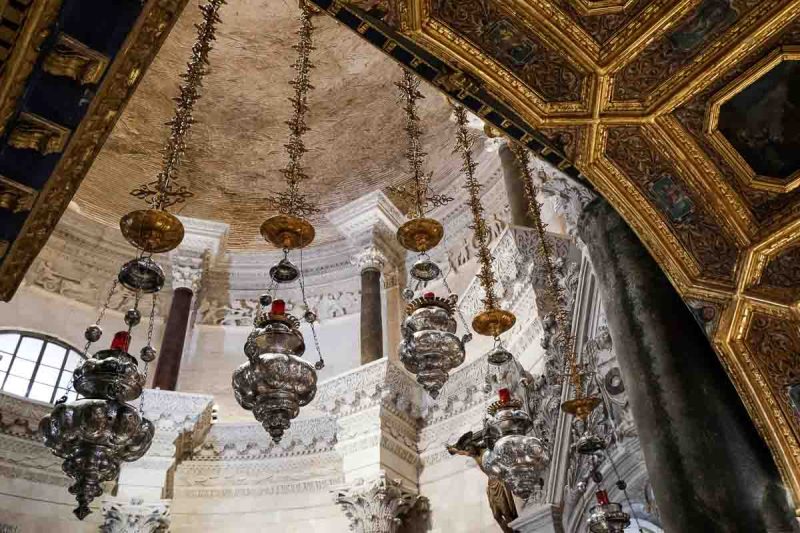
Before you exit the cathedral, take a few minutes to admire its doors. These striking 13th Century walnut and oak doors are carved with a chronological sequence of 28 scenes from the life of Christ.
The Baptistry (Temple of Jupiter)
Exiting the Cathedral of St Domnius, walk along the narrow alley to reach the baptistry straight ahead.
Demanding that he be worshipped as the son of Jupiter, the god of sky and thunder, Diocletian built a temple to honour his father. Although the approach to Jupiter’s Temple at the end of a dark alley doesn’t do it justice, it is still an imposing sight.
Once inside, cast your gaze upwards to its barrel-vaulted ceiling.
The ceiling’s 64 panels each display a face portraying a human emotion. Although it’s a mystery why the ceiling of Jupiter’s Temple was painted in this way, it may have had something to do with the religious rituals that once took place there.
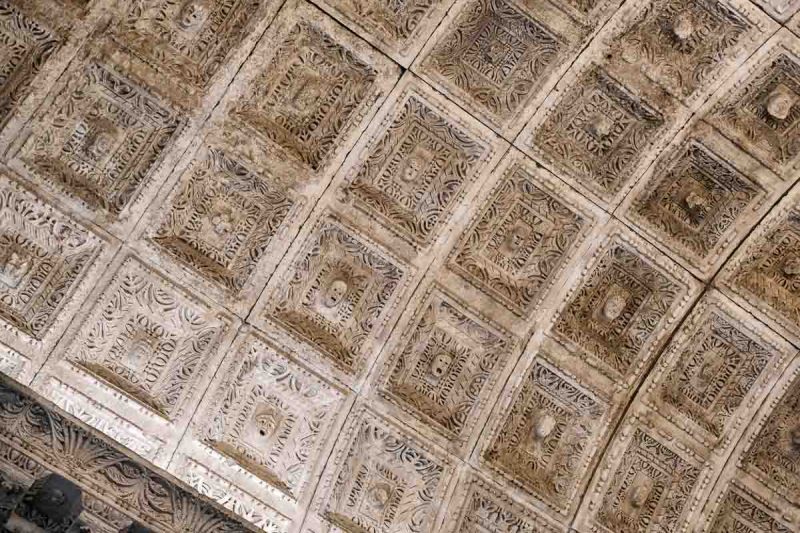
The Crypt
Make your way back to the side of the cathedral and descend a small set of steps to its crypt. This circular space surrounded by niches is a peaceful escape from the crowds in Split.
The Vestibule
For the perfect photo opportunity, don’t leave Split before checking out the vestibule.
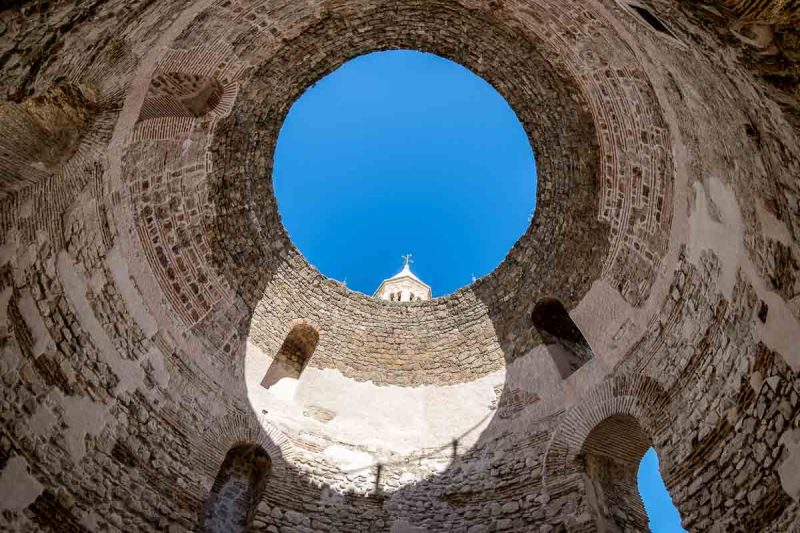
With the sphinx and the cathedral on your left-hand side, ascend the stone steps at the end of the Peristyle to a cone-shaped roofless chamber. This was the vestibule of Diocletian’s Palace, where visitors would wait before being granted an audience with the emperor.
If you continue walking through the Vestibule you will reach the area that once housed Diocletian’s living quarters. Latterly, these found new life as medieval tenement buildings.
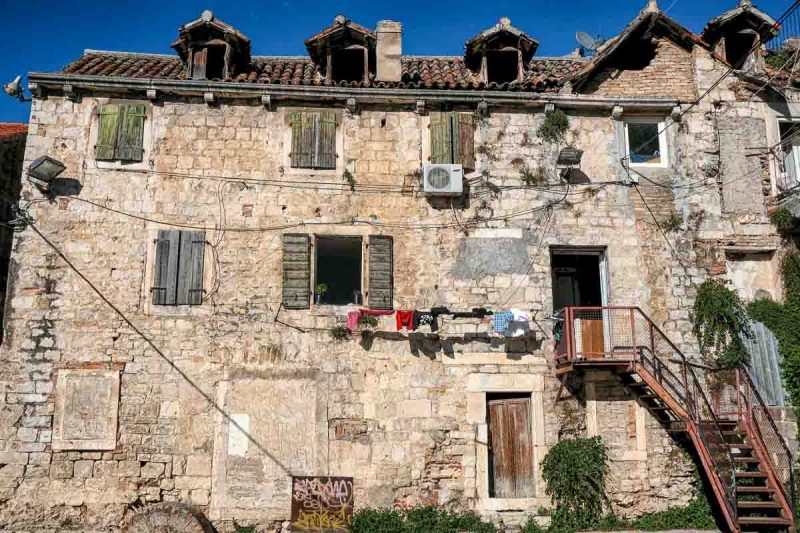
Would you prefer to explore Diocletian’s Palace with a guide? Click here to book a place on a highly-rated walking tour
How I Visited Split on a Cruise
I visited Split on a Greece and Adriatic Sea cruise on MSC Sinfonia. The ship was in port from 7 am until 5 pm.
Cruise ships berth at Split’s port, a ten-minute walk along the quayside from the old town, which lies within the area once occupied by Diocletian’s Palace. As Split’s main attractions are scattered over a relatively compact area, everything is walkable.
Getting your hands on a good guidebook to help you plan your Greek islands & Adriatic cruise, and to make the most of your time onshore, is a wise move. I’m a big fan of Rick Steves and his guide to Mediterranean cruise ports is packed full of useful information.
If you have found this article helpful, take a look at my guides to the other stops on this Adriatic Sea cruise:
- Off the Beaten Path in Split, Croatia
- A War Walk in Dubrovnik: A Scarred Beauty
- A Day in Urbino: A Renaissance Gem
- Should You Visit Santorini on a Cruise?
Finally, if you are a cruise rookie, I also have advice on how to book your first cruise and which cruise cabins to avoid, as well as advice on single cabins if you are cruising solo.

About Bridget
Bridget Coleman has been a passionate traveller for more than 30 years. She has visited 70+ countries, most as a solo traveller.
Articles on this site reflect her first-hand experiences.
To get in touch, email her at hello@theflashpacker.net or follow her on social media.
